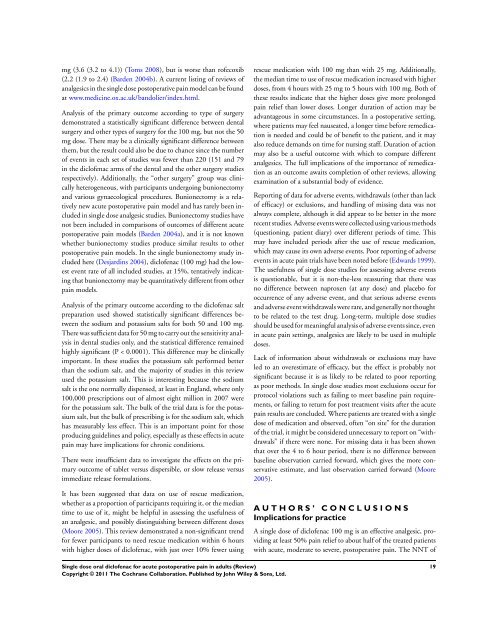Single dose oral diclofenac for acute postoperative pain in adults
Single dose oral diclofenac for acute postoperative pain in adults
Single dose oral diclofenac for acute postoperative pain in adults
You also want an ePaper? Increase the reach of your titles
YUMPU automatically turns print PDFs into web optimized ePapers that Google loves.
mg (3.6 (3.2 to 4.1)) (Toms 2008), but is worse than rofecoxib(2.2 (1.9 to 2.4) (Barden 2004b). A current list<strong>in</strong>g of reviews ofanalgesics <strong>in</strong> the s<strong>in</strong>gle <strong>dose</strong> <strong>postoperative</strong> <strong>pa<strong>in</strong></strong> model can be foundat www.medic<strong>in</strong>e.ox.ac.uk/bandolier/<strong>in</strong>dex.html.Analysis of the primary outcome accord<strong>in</strong>g to type of surgerydemonstrated a statistically significant difference between dentalsurgery and other types of surgery <strong>for</strong> the 100 mg, but not the 50mg <strong>dose</strong>. There may be a cl<strong>in</strong>ically significant difference betweenthem, but the result could also be due to chance s<strong>in</strong>ce the numberof events <strong>in</strong> each set of studies was fewer than 220 (151 and 79<strong>in</strong> the <strong>diclofenac</strong> arms of the dental and the other surgery studiesrespectively). Additionally, the “other surgery” group was cl<strong>in</strong>icallyheterogeneous, with participants undergo<strong>in</strong>g bunionectomyand various gynaecological procedures. Bunionectomy is a relativelynew <strong>acute</strong> <strong>postoperative</strong> <strong>pa<strong>in</strong></strong> model and has rarely been <strong>in</strong>cluded<strong>in</strong> s<strong>in</strong>gle <strong>dose</strong> analgesic studies. Bunionectomy studies havenot been <strong>in</strong>cluded <strong>in</strong> comparisons of outcomes of different <strong>acute</strong><strong>postoperative</strong> <strong>pa<strong>in</strong></strong> models (Barden 2004a), and it is not knownwhether bunionectomy studies produce similar results to other<strong>postoperative</strong> <strong>pa<strong>in</strong></strong> models. In the s<strong>in</strong>gle bunionectomy study <strong>in</strong>cludedhere (Desjard<strong>in</strong>s 2004), <strong>diclofenac</strong> (100 mg) had the lowestevent rate of all <strong>in</strong>cluded studies, at 15%, tentatively <strong>in</strong>dicat<strong>in</strong>gthat bunionectomy may be quantitatively different from other<strong>pa<strong>in</strong></strong> models.Analysis of the primary outcome accord<strong>in</strong>g to the <strong>diclofenac</strong> saltpreparation used showed statistically significant differences betweenthe sodium and potassium salts <strong>for</strong> both 50 and 100 mg.There was sufficient data <strong>for</strong> 50 mg to carry out the sensitivity analysis<strong>in</strong> dental studies only, and the statistical difference rema<strong>in</strong>edhighly significant (P < 0.0001). This difference may be cl<strong>in</strong>icallyimportant. In these studies the potassium salt per<strong>for</strong>med betterthan the sodium salt, and the majority of studies <strong>in</strong> this reviewused the potassium salt. This is <strong>in</strong>terest<strong>in</strong>g because the sodiumsalt is the one normally dispensed, at least <strong>in</strong> England, where only100,000 prescriptions out of almost eight million <strong>in</strong> 2007 were<strong>for</strong> the potassium salt. The bulk of the trial data is <strong>for</strong> the potassiumsalt, but the bulk of prescrib<strong>in</strong>g is <strong>for</strong> the sodium salt, whichhas measurably less effect. This is an important po<strong>in</strong>t <strong>for</strong> thoseproduc<strong>in</strong>g guidel<strong>in</strong>es and policy, especially as these effects <strong>in</strong> <strong>acute</strong><strong>pa<strong>in</strong></strong> may have implications <strong>for</strong> chronic conditions.There were <strong>in</strong>sufficient data to <strong>in</strong>vestigate the effects on the primaryoutcome of tablet versus dispersible, or slow release versusimmediate release <strong>for</strong>mulations.It has been suggested that data on use of rescue medication,whether as a proportion of participants requir<strong>in</strong>g it, or the mediantime to use of it, might be helpful <strong>in</strong> assess<strong>in</strong>g the usefulness ofan analgesic, and possibly dist<strong>in</strong>guish<strong>in</strong>g between different <strong>dose</strong>s(Moore 2005). This review demonstrated a non-significant trend<strong>for</strong> fewer participants to need rescue medication with<strong>in</strong> 6 hourswith higher <strong>dose</strong>s of <strong>diclofenac</strong>, with just over 10% fewer us<strong>in</strong>grescue medication with 100 mg than with 25 mg. Additionally,the median time to use of rescue medication <strong>in</strong>creased with higher<strong>dose</strong>s, from 4 hours with 25 mg to 5 hours with 100 mg. Both ofthese results <strong>in</strong>dicate that the higher <strong>dose</strong>s give more prolonged<strong>pa<strong>in</strong></strong> relief than lower <strong>dose</strong>s. Longer duration of action may beadvantageous <strong>in</strong> some circumstances. In a <strong>postoperative</strong> sett<strong>in</strong>g,where patients may feel nauseated, a longer time be<strong>for</strong>e remedicationis needed and could be of benefit to the patient, and it mayalso reduce demands on time <strong>for</strong> nurs<strong>in</strong>g staff. Duration of actionmay also be a useful outcome with which to compare differentanalgesics. The full implications of the importance of remedicationas an outcome awaits completion of other reviews, allow<strong>in</strong>gexam<strong>in</strong>ation of a substantial body of evidence.Report<strong>in</strong>g of data <strong>for</strong> adverse events, withdrawals (other than lackof efficacy) or exclusions, and handl<strong>in</strong>g of miss<strong>in</strong>g data was notalways complete, although it did appear to be better <strong>in</strong> the morerecent studies. Adverse events were collected us<strong>in</strong>g various methods(question<strong>in</strong>g, patient diary) over different periods of time. Thismay have <strong>in</strong>cluded periods after the use of rescue medication,which may cause its own adverse events. Poor report<strong>in</strong>g of adverseevents <strong>in</strong> <strong>acute</strong> <strong>pa<strong>in</strong></strong> trials have been noted be<strong>for</strong>e (Edwards 1999).The usefulness of s<strong>in</strong>gle <strong>dose</strong> studies <strong>for</strong> assess<strong>in</strong>g adverse eventsis questionable, but it is non-the-less reassur<strong>in</strong>g that there wasno difference between naproxen (at any <strong>dose</strong>) and placebo <strong>for</strong>occurrence of any adverse event, and that serious adverse eventsand adverse event withdrawals were rare, and generally not thoughtto be related to the test drug. Long-term, multiple <strong>dose</strong> studiesshould be used <strong>for</strong> mean<strong>in</strong>gful analysis of adverse events s<strong>in</strong>ce, even<strong>in</strong> <strong>acute</strong> <strong>pa<strong>in</strong></strong> sett<strong>in</strong>gs, analgesics are likely to be used <strong>in</strong> multiple<strong>dose</strong>s.Lack of <strong>in</strong><strong>for</strong>mation about withdrawals or exclusions may haveled to an overestimate of efficacy, but the effect is probably notsignificant because it is as likely to be related to poor report<strong>in</strong>gas poor methods. In s<strong>in</strong>gle <strong>dose</strong> studies most exclusions occur <strong>for</strong>protocol violations such as fail<strong>in</strong>g to meet basel<strong>in</strong>e <strong>pa<strong>in</strong></strong> requirements,or fail<strong>in</strong>g to return <strong>for</strong> post treatment visits after the <strong>acute</strong><strong>pa<strong>in</strong></strong> results are concluded. Where patients are treated with a s<strong>in</strong>gle<strong>dose</strong> of medication and observed, often “on site” <strong>for</strong> the durationof the trial, it might be considered unnecessary to report on “withdrawals”if there were none. For miss<strong>in</strong>g data it has been shownthat over the 4 to 6 hour period, there is no difference betweenbasel<strong>in</strong>e observation carried <strong>for</strong>ward, which gives the more conservativeestimate, and last observation carried <strong>for</strong>ward (Moore2005).A U T H O R S ’ C O N C L U S I O N SImplications <strong>for</strong> practiceA s<strong>in</strong>gle <strong>dose</strong> of <strong>diclofenac</strong> 100 mg is an effective analgesic, provid<strong>in</strong>gat least 50% <strong>pa<strong>in</strong></strong> relief to about half of the treated patientswith <strong>acute</strong>, moderate to severe, <strong>postoperative</strong> <strong>pa<strong>in</strong></strong>. The NNT of<strong>S<strong>in</strong>gle</strong> <strong>dose</strong> <strong>oral</strong> <strong>diclofenac</strong> <strong>for</strong> <strong>acute</strong> <strong>postoperative</strong> <strong>pa<strong>in</strong></strong> <strong>in</strong> <strong>adults</strong> (Review)Copyright © 2011 The Cochrane Collaboration. Published by John Wiley & Sons, Ltd.19












